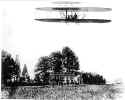 he
Wrights and Charlie Taylor assembled their new airplane and had it
airworthy on June 24, 1909. But they declined to fly, even when the entire
Senate showed up on June 26 and asked to be given a demonstration. The
Wrights were determined that nothing would go wrong with this second set
of trials, and the double-checked and triple-checked every screw and wire.
"They tinkered and fussed and muttered to themselves from dawn to
dusk," said Lt. Benny Foulais, who would later become one of the
Army's first military pilots. "It seemed as if they would never say
they were ready to go." he
Wrights and Charlie Taylor assembled their new airplane and had it
airworthy on June 24, 1909. But they declined to fly, even when the entire
Senate showed up on June 26 and asked to be given a demonstration. The
Wrights were determined that nothing would go wrong with this second set
of trials, and the double-checked and triple-checked every screw and wire.
"They tinkered and fussed and muttered to themselves from dawn to
dusk," said Lt. Benny Foulais, who would later become one of the
Army's first military pilots. "It seemed as if they would never say
they were ready to go."
On June 29, Orville finally took to the air � he would do all the
flying for these trials. It was a shaky start. He smashed a skid on the
second day and tangled with a thorn tree on the next. One wing was badly
ripped, and Orville dashed back to Dayton for a new wing covering.
When he flew again on July 12, he had finally shaken the bad
"hoodoo" that plagued him. He began to make long, trouble-free
flights. On July 27, he set a new duration record for a flight with a
passenger of 1 hour and 12 minutes. The Army was impressed, especially
since one of their requirements was that the flying machine be able to
remain aloft for one hour with an observer on board.
Perhaps the most important requirement was that the airplane be able to fly at
least 40 miles per hour. The need for speed was what concerned the
brothers the most, and for good reason. For every mile per hour under that speed, the
Army would deduct $2500 from the base price of $25,000 for the aircraft.
For every mile over 40 miles per hour, they would pay an additional $2500.
Orville flew the speed trial on July 30. He took off with Benny Foulais
on board, made a slow climbing turn to tree-top level, and headed for
Shooter's Hill, about 10 miles away. As he rounded the balloon the Army
had tethered on the hill, Foulais started his stopwatch. Orville made a
steady climb to 400 feet � another record. As soon as he had the Fort
Meyer parade grounds in sight, he nosed the aircraft down slightly and
began to pick up speed. Foulais stopped his watch as Orville shot past the
launching derrick. Orville flew a victory circle around Arlington Cemetery
and landed. Wilbur came running up, a huge grin on his face. Orville had
flown an average speed of 42.583 miles per hour � yet another record �
qualifying the Wrights for a bonus of $5000. The U.S. Army would pay
$30,000 for the world's first practical military aircraft. |
Click
on a photo to enlarge it.

The new and improved 1909 Wright Military
Flyer arriving at the Fort Meyer proving grounds on the back of a
wagon.

Katharine Wright, no longer teaching at Steele High
School, had become a common sight at test flights.

Soldiers help move the Flyer to the launch track.

Orville and Wilbur readying the Flyer.

Orville about the parade grounds at Fort Meyer.

Orville sets a record during the speed trials.

A victory lap over Arlington Cemetary.
|